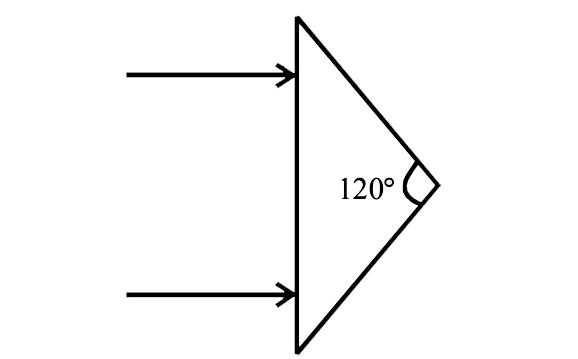
An isosceles prism of angle 120degree has a refractive index 1.44. Two parallel monochromatic rays enter the prism parallel to each other in air as shown. The rays emerge from the opposite faces
are parallel to each other
are diverging
make an angle 2sin−1(0.72) with each other
make an angle 2{sin−1(0.72)−30∘} with each other
The correct Answer is:D
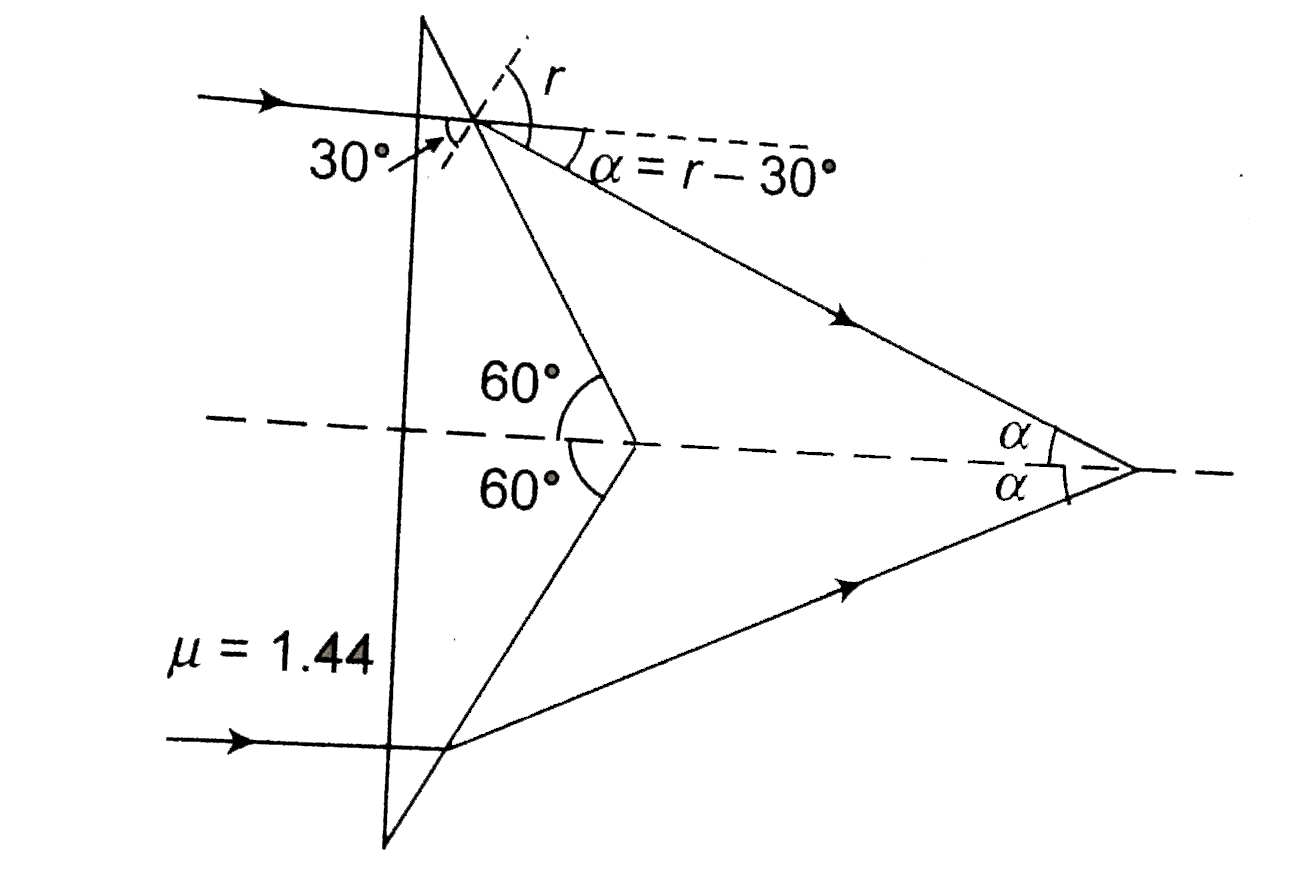
μsin30∘=1×sinr
1.44×12=sinr
r=sin−1(0.72)
Angle between emergent rays
=2α=2(r−30∘)
=2(sin−1(0.72)−30∘)
Topper's Solved these Questions
- REFRACTION OF LIGHT BY PLANE SURFACESBOOK - CP SINGHCHAPTER - REFRACTION OF LIGHT BY PLANE SURFACESEXERCISE - Exercises
110 Videos
- REFRACTION AT SPHERICAL SURFACESBOOK - CP SINGHCHAPTER - REFRACTION AT SPHERICAL SURFACESEXERCISE - EXERCISES
105 Videos
- SEMICONDUCTORSBOOK - CP SINGHCHAPTER - SEMICONDUCTORSEXERCISE - Exercises
140 Videos
Similar Questions
When light moves from one medium to another
(i) the frequency of light remains same and wavelength changes
(ii) refractive index of a medium is the ratio of speed of light in vacuum and speed of light in medium
(iii) refractive index of a medium is the ratio of wavelength of light in vacuum and wavelength in medium
(iv) for denser medium, the value of refractive index is larger
View Solution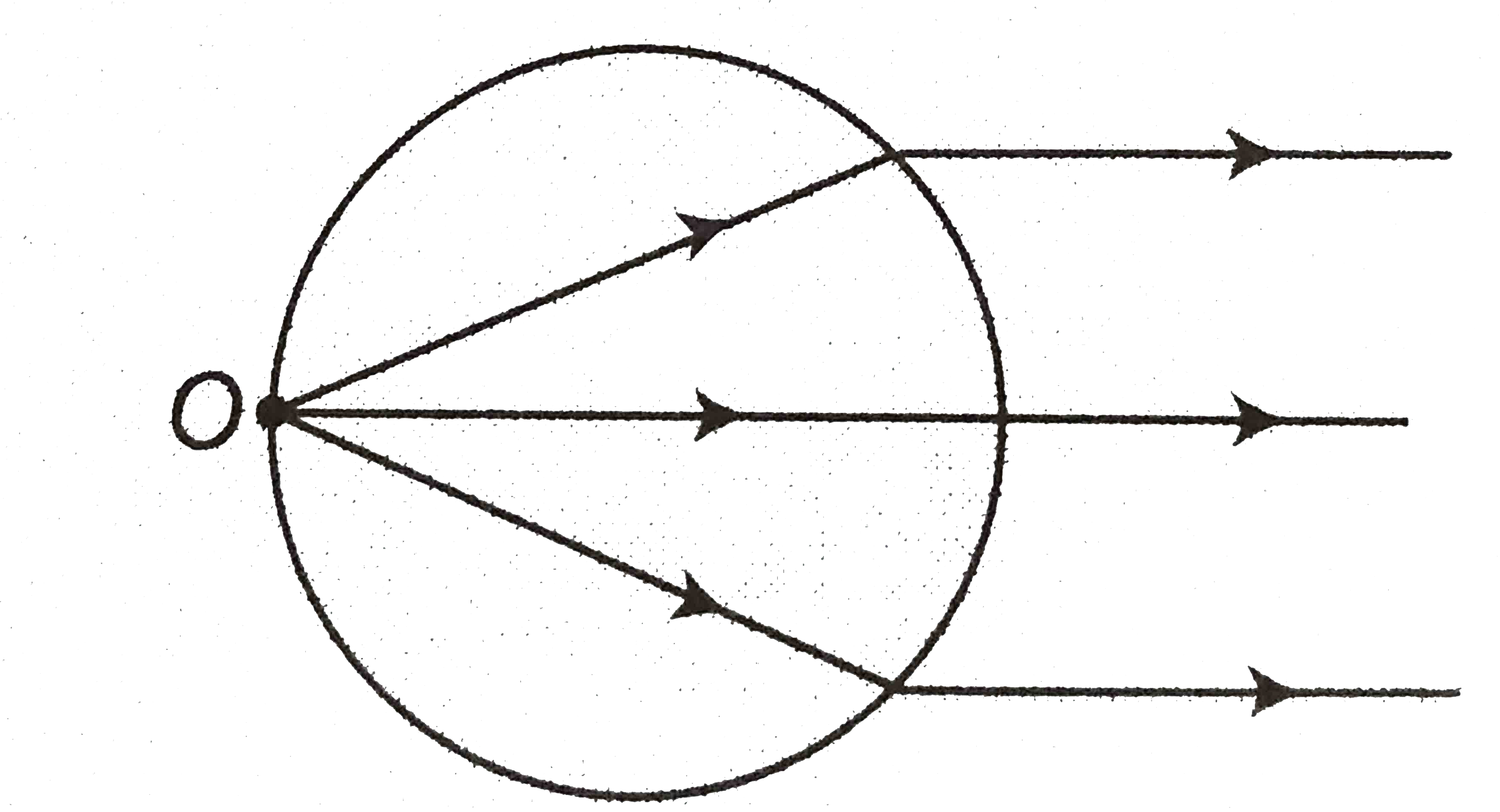
An object O is stuck on the surface of a transparent solid spher of radius 20 cm. Find refractive index of the sphere such that rays from the object after refraction from the opposite side emerge as a parallel beam, as shown Also prove that refractive index has the same value in the given situation for any value of radius of sphere.
View SolutionWhich of the followin is correct regarding band theroy of solids?
View SolutionAn isosceles prism of angle 120degree has a refractive index 1.44. Two parallel monochromatic rays enter the prism parallel to each other in air as shown. The rays emerge from the opposite faces
View SolutionThe prism shown in figure has a refractive index of 1.60 and the angles A are 30^@. Two light rays P and Q are parallel as they enter the prism. What is the angle between them after they emerge? [sin^-1(0.8)=53^@]
View SolutionAn isosceles prism has one of the refracting surfaces silvered. A ray of light is incident normally on the refracting face AB. After two reflections, the ray emerges from the base of the prism perpendicular to it. Find the angle of the prism.
View SolutionA ray of light enters the face AB of a glass prism of refractive index μ at an angle of incidence i. Find the value of i such that no ray emerges from the face AC of the prism, given angle of prism is A.
View SolutionA ray of monochromatic light is incident on one refracting face of a prism of angle 75^(@) . It passes through the prism and is incident on the other face at the critical angle. If the refractive index of the material of the prism is sqrt2 , the angle of incidence on the first face of the prism is
View SolutionA ray of light is incident at an angle of 60∘ on one face of a 30∘ prism . The emergent ray from the prism makes an angle of 30∘ with the incident ray. The angle of emergence and refractive index of the material of the prism are-
View SolutionA prism of refractive index √32 and refracting angle is 45∘ is placed in air. One of the two refracting surface of the prism is silvered and a ray of monochromatic light enters the prism from the other face at an angle θ. If the ray retraces its path, then what is the value of θ (in degree)?
View Solutionएक समद्विबाहु प्रिज्म का कोण 120∘ तथा उसके पदार्थ का अपवर्तनांक 1.44 है | एकवर्णी प्रकाश की दो समान्तर किरणें चित्रानुसार प्रिज्म में प्रवेश करती हैं | किरणें विपरीत पृष्ठ से बाहर आने वाली किरणें

View SolutionA monochromatic ray of light in incident normally on a refracting face of a prism of angle 30∘ . The refractive index of the material of the prism 1.5 .
The angle of emergence will be
View Solutionदो समान्तर प्रकाश किरणें एक प्रिज्म के एक पृष्ठ पर आपतित होती है। प्रिज्म का अपवर्तनांक 1.5 है। निकलने वाली किरणों के बीच कोण है
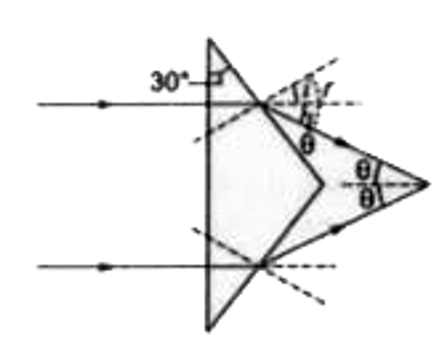
View SolutionFor right-angled prism, ray-1 is the incident ri and ray-2 is the emergent ray as shown in the figure. Refractive index of the prism is .........
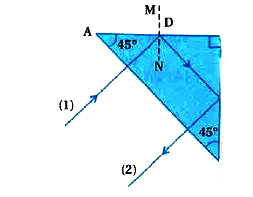
View SolutionA ray of monochormatic light is incident on one refracting face of a prism of angle 75∘. It passes through the prism an is incident on the other at the critical angle. If the refractive index of the material of the prism is √2, the angle of the first face of the prism is
View SolutionAn isosceles prism of angle 120^(@) has a refractive index of 1.44. Two parallel monochromatic rays enter the prism paralled to each other in air as shown. The rays emerging from the opposite faces
View Solution

